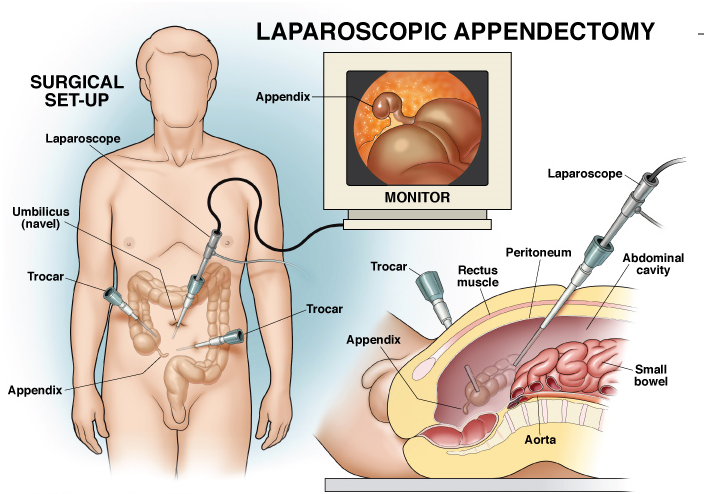Lap Appendectomy

Lap Appendectomy
Appendix is a small blind ended tube of the size of your finger projecting from cecum. Cecum is the junction where the small intestine and the large intestine meet. The functional purpose of appendix is not known to medical science. In some persons the appendix may become infected by bacteria causing inflammation and formation of pus. Causes for infection can be mechanical blockage by stool, or a foreign substance etc. The inflamed condition of the appendix is known as appendicitis. In severe cases the appendicitis, the appendix may burst which can be fatal.
Symptoms
Symptoms of appendicitis is severe and sharp pain experienced in the belly bottom which shifts to lower right side. Movement like walking etc can increase the intensity of pain. Patients may also develop symptoms like vomiting, constipation, diarrhea, abdominal swelling etc.
Diagnosis
Diagnostic procedure starts with studying the medical history of the patient and by conducting a physical examination. Most patients will have elevated temperature and tenderness in the abdomen. Count of white blood cells and urinalysis are useful to a certain extent in diagnosing appendicitis. Diagnostic tools like X-ray, ultra sound scan, CT scan etc are made use of for diagnosing appendicitis. Ultrasound sound is successful in identifying 50 % of the appendicitis cases. Barium emma test is another diagnostic test in which barium is pushed into the colon through anus and X-rays are taken. The benefit of this test is that it can exclude other reasons which mimic the symptoms of appendicitis. Diagnostic test helps to evalvuate whether to go for appendix removal surgery based on the inflammation of appendix.
Laparoscopic procedure
Laparoscopic procedure for the removal appendix is carried out under general anesthesia which is also called as laparoscopic appendectomy. The patient is asked to lie in supine position with his arms tucked at sides. Usually three ports are made in the abdomen through which fiber optic tube with a camera on top of it and other instruments needed for the surgical procedure are inserted. The camera connected at the end of the fiber optic tube helps to get a clear view of the abdominal organs and the appendix. Viewing these videos in the monitor placed in the operation theater, the Laparoscopic surgeon carries out the appendix removal surgery controlling the inserted instruments for surgery remotely. The inflamed appendix is located and the same is cut and removed. Before finishing the surgery, the surgeon examines the abdomen for any possible hemorrhage or bowel injury. All the instruments are removed and the ports are closed by suturing.
Advantages
- This is minimally invasive and therefore it needs only lesser dissection of tissues.
- Less pain is felt after the surgery and less recovery period is required.
- It has a better cosmetic effect than the traditional surgery as it is less invasive.
- Lesser complications during the operation and after the operation.
OUR TEAM

Dr. Nagaraj B Puttaswamy
Senior Consultant - Laparoscopic Surgeon Bariatric Surgeon and Surgical Gastroenterologist


